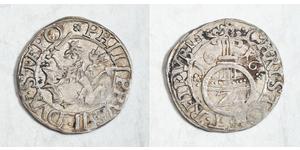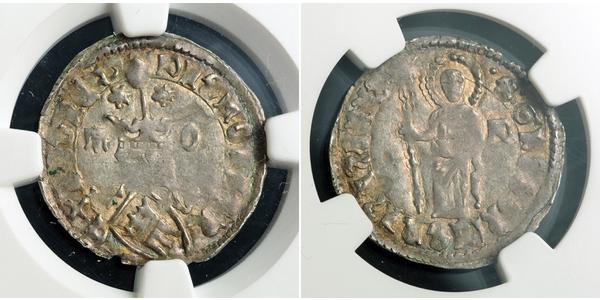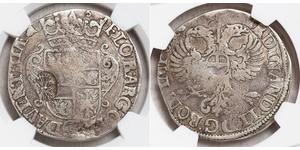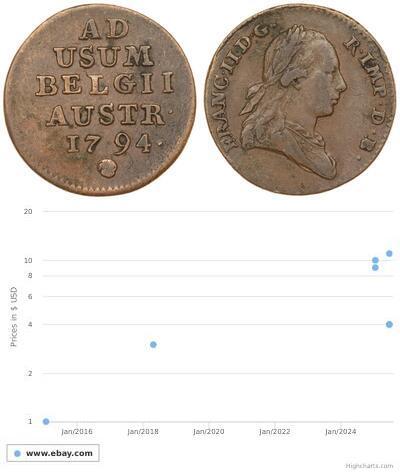(Verkauft für $153.0)
1461, Bosnia, Stephen Thomas (Thomas Ostojic). Silver Grossus Coin. NGC XF-40!
Reference: Hadz 655. Mint Period: 1443-1461 Denomination: Grossus (Groschen) Condition: Certified and graded by NGC as XF-40! Diameter: 23mm Weight: 1.18gm Material: Silver
Obverse: Crowned helmet above shield with crowned initial (T) in shield, which splits legend. Initials (T-O) in fields. Legend: I-ONS TOMAS-REX BONEN # . Reverse: St. Gregory standing, holding long cross; letter (R) in right field Legend: S GREGORI NAZENSIS
Stephen Thomas (Serbo-Croatian: Stjepan Tomaš/Стјепан Томаш; c. 1411 – 10 July 1461) was a member of the House of Kotromanić who reigned as the penultimate King of Bosnia from 1443 until his death. He succeeded his kinsman, Stephen Tvrtko II, but was not recognized as king by the kingdom's leading nobleman, Stjepan Vukčić Kosača. The two engaged in a civil war which ended with the King's marriage to the insubordinate nobleman's daughter Catherine. His reign was marked by conflicts with the Serbian Despotate and the Ottoman Empire. Thomas is perhaps best known as the first ruler of Bosnia who engaged in religious persecution. He was succeeded by his son, Stephen Tomašević, but the Kingdom fell to the Ottomans within two years.
Thomas was a son of King Ostoja, who died in 1418, and his mistress, whose name is not recorded. He was a doubly adulterine child, as both his father and mother were married at the time of his birth, and was raised as a member of the Bosnian Church, to which his parents adhered. Stephen Ostojić, Ostoja's only known legitimate child and successor, was deposed by Tvrtko II in 1421. Thomas' likewise illegitimate older brother Radivoj unsuccessfully contested Tvrtko's rule with the help of the Ottoman Empire. Ostoja was the only non-Catholic King of Bosnia, being a member of the Bosnian Church; it is likely that Thomas was also raised as an adherent of the Bosnian Church.
Ostoja's, and therefore Thomas and Radivoj's, relationship with Tvrtko II and the rest of the House of Kotromanić is disputed. In a charter issued upon his accession, Thomas described Tvrtko II as his patruus, a Latin word that means "paternal uncle" if used as a noun, but "paternal uncle's son" if used as an adjective. The uncertainty is somewhat cleared by Ostoja's charters in which he referred to Tvrtko I, Tvrtko II's father, as his "late brother". The historian Dominik Mandić notes that, while cousins sometimes addressed each other as brothers, it would have been highly unusual for a person to describe his or her father as brother. Mandić thus concludes that Thomas was a patrilineal first cousin of Tvrtko II.
Count Hermann II of Celje, a descendant of the House of Kotromanić whom the childless King Tvrtko II had recognized as heir presumptive, died in 1435. When the King himself died in November 1443, the authorities of the neighbouring Republic of Ragusa immediately expressed concern about the uncertainty of succession. By 5 December, Thomas had been enthroned as the new king. His accession must have been decided by the nobility at a stanak, although he later claimed to have been designated heir by Tvrtko II. Stjepan Vukčić, the kingdom's most powerful magnate, did not take part in the election and did not consent to it. He immediately took up the cause of Thomas's brother Radivoj. Stjepan and Radivoj appealed to Ragusa not to recognize Thomas as king, but to no avail. Simultaneously, Hermann's grandson Ulrich II pressed his claim to the Bosnian throne and tried to gather support among Thomas's opponents Hungary only recognized Thomas in June 1444, thanks to John Hunyadi's intercession with King Vladislaus I. Grateful, Thomas promised to help John in every matter, free passage and shelter in Bosnia, and an annual income.
The Kingdom of Hungary, nominal overlord of the Kingdom of Bosnia, had too much trouble of its own to interfere in the succession, with supporters of Hermann's great-grandson, King Ladislaus V, caught up in a war against the partisans of King Vladislaus I. Thomas was most likely designated heir by Tvrtko himself, as the former claimed in a charter he later issued, because the ailing King wished to ensure that the crown would not pass to his despised rival Radivoj. As the succession passed rather smoothly, it is safe to assume that Tvrtko had paved the way for Thomas's accession. The only nobleman who supported Radivoj was the most powerful one – the Grand Duke of Bosnia Stjepan Vukčić Kosača, who did not participate in Thomas' election. One of Thomas's important early achievements, in the beginning of 1444, was retaking the lucrative silver mining town of Srebrenica, which had been conquered by Đurađ Branković, Despot of Serbia.[3]
King Thomas's first wife was Vojača, whom he had married according to the laws and customs of the Bosnian Church before he became king. She was the mother of his eldest son, Stephen Tomašević. Upon his accession, however, the nobility objected to her humble origin, and Thomas was forced to repudiate her. Pope Eugene IV easily granted him the annulment on 29 May 1445, as the marriage was considered invalid under Roman Catholic teaching, and at the same time legitimated his birth and recognized him as King of Bosnia.
A civil war escalated between the King and the Grand Duke soon after the former's accession. The papacy at the time strived to create a powerful counter-offensive against the Ottoman Empire, but papal envoys sent to the King and the Grand Duke failed to secure their full participation in the Crusade of Varna due to their internal conflict. Vladislaus I died in the Battle of Varna on 10 November 1444, leaving Ladislaus V as the uncontested King of Hungary. John Hunyadi, regent for the underage King Ladislaus, formally recognized Thomas as King of Bosnia. John Hunyadi sent him no troops, however, while the Grand Duke received military support from the Ottomans and their vassal, Đurađ Branković.
Thomas was converted to Roman Catholicism by Thomas of Hvar in early 1446, but was not baptized until the late 1450s, when Cardinal Carvajal was dispatched to perform the ceremony. A large number of Bosnian noblemen followed the King's example – although some later returned to the Bosnian Church. Even Grand Duke Stjepan contemplated leaving the Bosnian Church to become a Roman Catholic, but never did. The King's civil war with him ended at that time, with lands and borders reverting to status quo ante bellum. As part of the peace settlement, in Milodraž on 26 May, Thomas married his former enemy's daughter Catherine, who had to join the Roman Catholic Church in order to become queen. The union was probably considered already in 1445, when the King asked the Pope to annul his first marriage. The couple erected a considerable number of churches and Franciscan monasteries.
The Ottomans wished to weaken Bosnia by encouraging internal division, and were thus dismayed when the civil war ended. So was Đurađ Branković, a traditional ally of the House of Kosača, due to his conflict with Thomas over the possession of Srebrenica. After the town changed hands twice between 1444 and 1446, the King and the Despot agreed that its revenues would be split between them, and that coins minted there would bear one ruler's name on one side and the other ruler's name on the other side.
In 1448, Stjepan Vukčić Kosača attempted to repair his relations with Đurađ Branković by announcing his independence from his son-in-law, Thomas, dropping the title of Grand Duke of Bosnia and calling himself first Duke of Hum and then Duke of Sava. When war broke out between Thomas and Đurađ Branković the same year, the King's father-in-law supported the Serbs; Srebrenica was conquered along with the entire left bank of the Drina. Srebrenica was recaptured by Thomas's forces and held briefly in 1449, but Serbia's alliance with the Ottoman Empire forced the King to accept the loss.
In April 1456, King Thomas refused to surrender four strategically important towns to the Ottomans, and their attacks became much more frequent. Đurađ Branković died the same year. When his son and successor, Lazar, died in 1458, Thomas seized the opportunity to reclaim Srebrenica, along with eleven other towns situated on the Drina's left bank. In 1459, he made peace with Lazar's widow, Helena Palaiologina, and procured the marriage of his eldest son, Stephen Tomašević, with her and Lazar's eldest daughter, Helena. He thereby secured his son's accession as Despot of Serbia, but found it necessary to apologize in writing to Francesco Sforza, Duke of Milan, as he had earlier envisioned a marriage between his son and the Duke's daughter. Stephen Tomašević's reign as despot did not last long. On 20 June 1459, the Ottomans conquered Smederevo Fortress and annexed Serbia. The Hungarians accused Thomas of selling Smederevo, but probably groundlessly.
Unlike in other Balkan states of the time, the politics of Bosnia were not dominated by religion, and its rulers were characterized by religious tolerance. Things changed in 1459, however, when the Ottoman threat became ever more looming. King Thomas asked Pope Pius II for help, but the Pope responded that he would not come to his aid for as long as the Bosnian Church was tolerated. The decision then taken by Thomas made him the first Bosnian ruler to persecute people on the account of their religion, a policy popes had long demanded from Bosnia's Catholic rulers. In 1459, Thomas required the clergy of the Bosnian Church to either convert or leave his realm. The exiles moved to the territory of the King's father-in-law. The King proceeded to confiscate vast properties and land belonging to the Church's monasteries. The persecution all but destroyed the Bosnian Church by the end of Thomas's reign.
King Thomas died on 10 July 1461. According to legend, he was murdered by his brother Radivoj and son Stephen Tomašević; the historian Vjekoslav Klaić asserts that the most likely cause was an illness, given that the King requested a physician from the Republic of Dubrovnik on 8 June. Stephen Tomašević succeeded him, and reigned until 1463, when the Ottomans executed both him and Radivoj and put an end to the Kingdom of Bosnia.
King Thomas was buried in the royal mausoleum in Bobovac. Based on the state of his teeth, the anthropologist Živko Mikić concluded that the King was about 50 years old when he died.
Thomas's character greatly impressed the Italian condottiero Gaspare Broglio da Lavello (son of Angelo Tartaglia), whom he met in 1452. Broglio wrote that he had never met a prince more refined and dignified, surpassing even Federico da Montefeltro, Broglio's idol.
King Thomas was married twice. The commoner Vojača was the mother of Stephen Tomašević, Thomas's elder surviving son and successor, and of three more children: two daughters and a son who died of fever at the age of 14 during a pilgrimage to Mljet. By his second wife, Catherine of St Sava, Thomas had a son named Sigismund and a daughter named Catherine.

|
Beigetragen von:
anonymous 2018-12-19 |

2/3 Thaler Deutschland Silber Ferdinand ...
Diese Gruppe hat 7 Münzen / 7 Preise
Add coin to this group

1/24 Thaler Duchy of Pomerania-Stettin S ...
Diese Gruppe hat 3 Münzen / 3 Preise
Add coin to this group

1 Ducat Principality of Transylvania (15 ...
Diese Gruppe hat 3 Münzen / 3 Preise
Add coin to this group

1/2 Guinea Königreich Großbritannien (17 ...
Diese Gruppe hat 11 Münzen / 8 Preise
Add coin to this group

1 Solidus Byzantinisches Reich (330-1453 ...
Diese Gruppe hat 27 Münzen / 18 Preise
Add coin to this group

25 Ore Norwegen Silber Haakon VII. (1872 ...
Diese Gruppe hat 13 Münzen / 13 Preise
Add coin to this group
990 coins were uploaded from 2025-05-21 to 2025-05-28
Eine von ihnen ist:

















